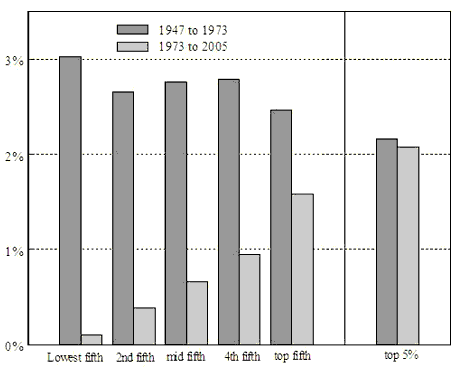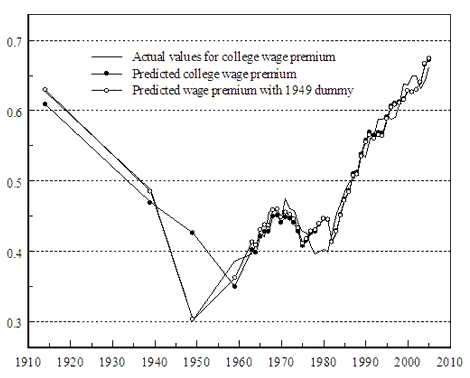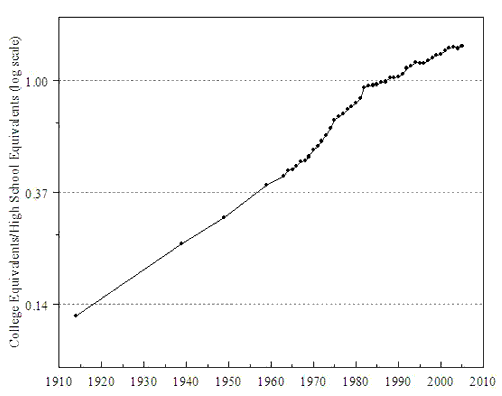US educational attainment growth has substantially slowed since the 1970s. This column explains how the educational slowdown caused much of the recent rise in economic inequality and concludes that the futures of inequality and the US depend on increasing the supply of highly educated workers.
The American Dream has been placed on hold. Putting aside the recent financial meltdown and the current recession – if you can – the main reason is an educational slowdown. For most of American history, the average American child was far more educated and better off financially than his parents. But ever since the 1970s, US growth in educational attainment for successive generations has substantially slowed. The slowdown in education spells trouble for economic growth and economic inequality, as many authors have noted, e.g. Heckman (2008).
An educated populace is a key source of economic growth directly, through the improved productivity of workers, and indirectly, by spurring innovation and aiding the diffusion of advanced technologies. Broad access to education was a major factor in US economic ascendancy and in the creation of a broad middle class. The American Dream of upward mobility both within and across generations has been tied to educational access.
Ever since the beginning of the twentieth century, technological change has operated to increase the relative demand for educated and skilled workers. In academic parlance, technological change has been “skill-biased” – smart machines require smart workers. Technological change increases the relative demand for skilled and educated workers, but educational advance increases their relative supply. This “race” between education and technology can produce rising, declining, or stable levels of economic inequality.
US economic inequality has been on a roller coaster ride during the past century. Wage inequality and educational wage differentials decreased from around 1910 to 1950. They remained fairly stable until about 1980, after which economic inequality soared. The contrasting descent and rise of economic inequality in the twentieth century is linked to the history of educational attainment.
Our book shows that the educational slowdown caused much of the recent rise in economic inequality. Similarly, the large increase in educational attainment earlier in the twentieth century produced greater economic equality and shared prosperity. Slowdowns and speedups in skill-biased technological change are far less important in accounting for the large swings in inequality than changes in the supply of skills. The rise and decline of unions plays a supporting role in the story, but it is rarely a major player. Immigration and international trade also do not play starring roles in explaining changes in economic inequality.
Long-term trends in inequality and the economic return to education
In the quarter century after World War II, the American economy grew rapidly and prosperity was widely shared. Mean real family income rose by an average of 2.64% annually from 1947 to 1973. Incomes for those in the bottom one-fifth of the income distribution rose by around 3% annually and incomes for those in the top one-fifth rose by around 2.5%. But during the subsequent three decades, the incomes of America’s families grew widely apart and the American economy was far less dynamic. From 1973 to 2005 mean family income rose by considerably more at the top of the distribution than at the bottom, but growth for each of the quintiles was lower than during the previous period.
Figure 1. Annual growth rate of real income across the family income distribution: 1947 to 1973 versus 1973 to 2005

Sources and Notes: US Census Bureau, Historical Income Tables, table F3, updated September 15, 2006. The figure plots the annual percentage growth rate in mean real family income by quintile and for the top 5 percent of families for 1947 to 1973 and 1973 to 2005. Incomes are converted to constant dollars using the Consumer Price Index Research Series (CPI-U-RS). The income concept used is the official US Census Bureau measure of pre-tax, post-transfer money income.
Evidence on economic inequality from the US federal population census begins in 1940. For the preceding years we rely mainly on wage differences by educational level. The rationale is that wage inequality is largely due to differences across individuals in the level and type of education. Increases in the economic returns to education account for about 60% of the rise in wage inequality from 1973 to 2005.
Our evidence demonstrates that the returns to education and the premium to skill, rather than rising for much of the century, decreased before 1950. The premium to years of high school and college was exceptionally high around 1915, even within broad occupational groupings such as blue collar workers and farmers.
Across the full twentieth century, economic inequality, measured by the college wage premium, appears to have come full circle. Rapidly rising wage inequality from 1980 to the present was preceded by equally rapid declining wage inequality and educational wage differentials before 1950. The returns to a year of college and high school around 1915 were as high as the returns to a year of college recently.
Figure 2. Actual and predicted (log) college wage premium: 1915 to 2005

Sources and Notes: The actual values for the college wage premium are from chapter 8, The Race between Education and Technology. The two series for the predicted college wage premium are the values from regressions in table 2, chapter 8.
What can explain the changes for the full twentieth century? One possibility is that skill-biased technological change greatly accelerated in the past several decades but was sluggish before. That is, “computers did it.”
The problem with the “computers did it” explanation is that technological change at the start of the twentieth century was just as rapid and skill-biased as it was during much of the remaining century. Skill-biased technological change is not new, and it did not greatly accelerate toward the end of the twentieth century.
The race
The reason for the two inequality tales of the twentieth century is contained in the extraordinary history of education in the US. Years of education increased rapidly and continuously for cohorts born from 1875 to 1950 (and educated in the US).
America was the world’s leader in mass (universal) education in the first half of the twentieth century. No other nation had as complete a shift to mass secondary school education before 1940. Educational attainment increased by almost one year per decade for cohorts born from 1875 to 1950. The increase was so great that the relative supply of educated workers outran demand. But something happened after 1970.
A sharp slowdown in educational attainment and high school graduation rates occurred for those born after 1950. College graduation rates began to slow and high school graduation rates hit a plateau. Once the world leader in high school graduation, the US has fallen in recent years to nearly the bottom of OECD nations; while it is still a leader in college attendance, college completion rates for recent cohorts are lagging other nations.
To understand the evolution of economic inequality over time, we have produced a measure of the relative supply of skills of the US workforce given by the ratio of college to non-college workers. From 1915 to 1960, the relative skill supply measure increased by 3% per annum and by a whopping 3.8% from 1960 to 1980. But from 1980 to 2005, the increase was just 2% per annum.
Figure 3. Ratio of college to high school workers (log scale): 1915 to 2005

Notes and Sources: The calculation of the log relative supply measure for college and high school worker equivalents is given in The Race between Education and Technology, chapter 8, table 1.
To explain the full century of inequality trends, we employ a simple framework that has a demand curve for skill shifting out through time at a relatively constant rate and a supply of skill function shifting out at a changing rate. We can accurately predict the relative earnings of college to non-college workers by using the actual shifts in the relative supply of educated workers and an assumption of a fairly constant increase in demand for them, presumably driven by skill-biased technical change.
We estimate the model over the years for which we have educational returns and education supply data, spanning 1915 to 2005. We include a time trend to capture the increased relative demand for educated workers and a few year breaks.
The “fitted” values from the model are given by the solid dots in Figure 2. The “fit” becomes almost perfect with the addition of a dummy variable for 1949, in recognition of the special institutions of the World War II era. We can explain a large part of changing economic inequality with a sparse set up – a relative demand function shifting out at a fairly constant rate together with a relative supply function that shifts out very rapidly and then slowly.
The big changes, both up and down, in the returns to education were due to shifts in the relative supply of educated workers. The relative supply of college workers increased at 3.8% per annum from 1960 to 1980, but at just 2% from 1980 to 2005. The most important factor accounting for the soaring college wage premium of the post-1980 period was the slowdown in the growth of educational attainment.
We also consider two auxiliary factors – unionisation and immigration trends. A simple calculation shows that declining unionisation can account for only 3 log points of the 23 log point college wage premium increase. The other factor is immigration. Because immigration increased greatly after 1970 and a large fraction arrived with little education, the recent sluggishness in education could be due to immigration. But it is not. The native-born population can be held accountable for most of the slowdown in college and high school graduation.
The future of inequality
The bottom line is that the future of inequality and this nation depend on increasing the supply of highly educated workers. Too many youth drop out of high school; too many high school graduates are not college-ready. Tuition levels for college are high and have risen relative to family incomes and student financial aid. America once grew rapidly, and its families grew together. Widespread and rapidly increasing education played a large role. The US made remarkable achievements in education from the early nineteenth century to the mid-twentieth century. Education was once the gateway to the American Dream. It still is.
References
Goldin, Claudia and Lawrence Katz (2008). The Race between Education and Technology, Belknap Press for Harvard University Press.
Heckman, James and Paul LaFontaine (2008). Educated in America: College graduates and high school dropouts, Vox column, 13 February 2008, VoxEU.org.
![]()
- Bulenox: Get 45% to 91% OFF ... Use Discount Code: UNO
- Risk Our Money Not Yours | Get 50% to 90% OFF ... Use Discount Code: MMBVBKSM
Disclaimer: This page contains affiliate links. If you choose to make a purchase after clicking a link, we may receive a commission at no additional cost to you. Thank you for your support!


Leave a Reply